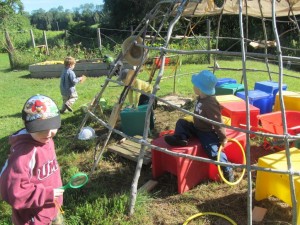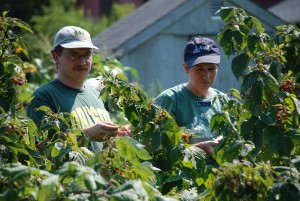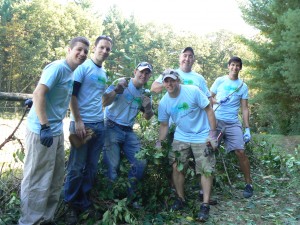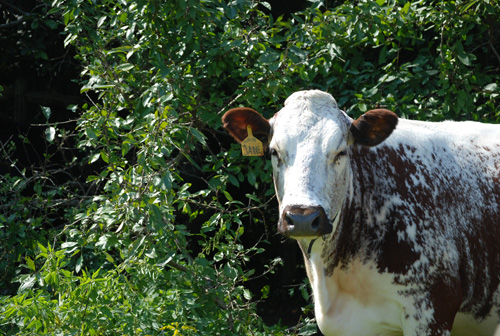The favorite part of the workday for any Drumlin Farm educator is without a doubt being out in the fields, forests, and wetlands of our sanctuary, working with students and seeing them learn through deep engagement and discovery with the natural world. But if we have to be indoors, then it’s hard to beat the learning and discovery we ourselves experienced at the annual Massachusetts STEM Summit.
A joint effort of the Governor’s STEM Advisory Council, Mass Business Roundtable, and the UMass Donahue Institute, and sponsored in part this year by Mass Audubon, the STEM Summit brings together educators from across the state for a day of presentations, workshops, and sharing around the four educational components known as “STEM” – science, technology, engineering, and math. The 10th annual Summit, held at Gillette Stadium in Foxboro, was attended by nearly 1,200 educators including classroom teachers, educational firms and organizations, and community-based educators like the eight attendees who participated from Mass Audubon.
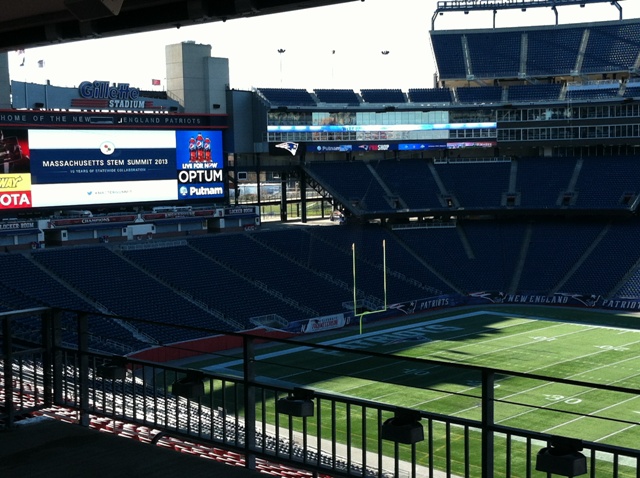 After an opening charge from Governor Deval Patrick, which unveiled Massachusetts STEM Plan 2.0, we spent the day buzzing about the complex, turning the box seats around the Patriots playing field into working laboratories for learning the latest philosophies, techniques, and tools for engaging students in STEM learning.
After an opening charge from Governor Deval Patrick, which unveiled Massachusetts STEM Plan 2.0, we spent the day buzzing about the complex, turning the box seats around the Patriots playing field into working laboratories for learning the latest philosophies, techniques, and tools for engaging students in STEM learning.
In one workshop, I explored workshops on methods ranging from project-based learning modules developed by the Boston Museum of Science, to digital gaming innovations from researchers at MIT’s Media Lab. One highlight of the workshops was working with two classroom teachers to build and test earthquake proof structures made from simple materials like paper, straws, and pipe cleaners. Meanwhile, Drumlin Farm Education Manager Kris Scopinich was learning about the newly drafted Massachusetts Science, Technology, and Engineering standards, and working with educators on how they will affect both in-school and out-of-school programming for PreK-12 students and teachers.
 During breaks, we wandered the exhibit halls, finding inspiration from the many nonprofit organizations, there to share their mission and opportunities, including Mass Audubon. Even the lunch-time presentation provided new ideas and inspiration, as we heard two young engineers share their passion and entrepreneurship in their journey to create a line of personally-piloted flying cars through their company Terrafugia.
During breaks, we wandered the exhibit halls, finding inspiration from the many nonprofit organizations, there to share their mission and opportunities, including Mass Audubon. Even the lunch-time presentation provided new ideas and inspiration, as we heard two young engineers share their passion and entrepreneurship in their journey to create a line of personally-piloted flying cars through their company Terrafugia.
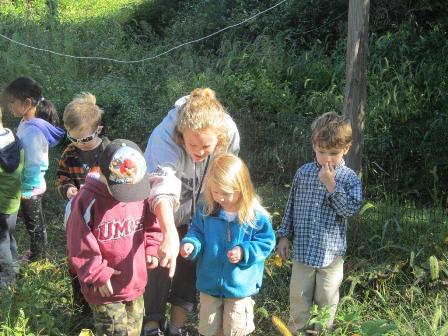 So if Mass Audubon is all about protecting the nature of Massachusetts, why did we devote a whole day inside to the STEM Summit? At the heart of how we approach our mission is finding ways to bring people closer to their environment through a process of science-based discovery. Over time, we have found innovative ways to incorporate math, engineering, and technology into our nature-based programming as well. Finding new ways to excite and engage our students in science will lead them to a deeper appreciation of the natural world, and subsequently a desire to protect it for future generations. At the same time, discovering ways to access nature through exciting new technologies and teaching tools helps us plug into kids and learning opportunities that we, and they, might not have found through more traditional methods. As we ourselves grow as educators through dynamic experiences such as an immersive day at the STEM Summit, we are able to bring new energy and ideas to our students back at Drumlin Farm, creating our own STEM revolution here in the fields, forests, and wetlands.
So if Mass Audubon is all about protecting the nature of Massachusetts, why did we devote a whole day inside to the STEM Summit? At the heart of how we approach our mission is finding ways to bring people closer to their environment through a process of science-based discovery. Over time, we have found innovative ways to incorporate math, engineering, and technology into our nature-based programming as well. Finding new ways to excite and engage our students in science will lead them to a deeper appreciation of the natural world, and subsequently a desire to protect it for future generations. At the same time, discovering ways to access nature through exciting new technologies and teaching tools helps us plug into kids and learning opportunities that we, and they, might not have found through more traditional methods. As we ourselves grow as educators through dynamic experiences such as an immersive day at the STEM Summit, we are able to bring new energy and ideas to our students back at Drumlin Farm, creating our own STEM revolution here in the fields, forests, and wetlands.
—Renata Pomponi is the Visitor Education Coordinator at Drumlin Farm.
 It’s strawberry time! We’re finally getting the heat that ripens the berries, and they’re coming on fast. We had lots for the stand on Tuesday, and we are confident there will be a good amount for this Saturday, June 21 at Strawberry Day.
It’s strawberry time! We’re finally getting the heat that ripens the berries, and they’re coming on fast. We had lots for the stand on Tuesday, and we are confident there will be a good amount for this Saturday, June 21 at Strawberry Day.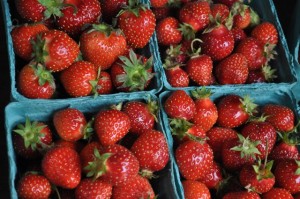 Stop by our farmstand during your visit to the farm to buy a pint for yourself while they are available. You can also us at the Union Square Farmers Market, Somerville Saturdays 9 am-1 pm, or at Watertown Market, Arsenal Mall, Watertown, from 3-7 pm June19 and 26.
Stop by our farmstand during your visit to the farm to buy a pint for yourself while they are available. You can also us at the Union Square Farmers Market, Somerville Saturdays 9 am-1 pm, or at Watertown Market, Arsenal Mall, Watertown, from 3-7 pm June19 and 26.


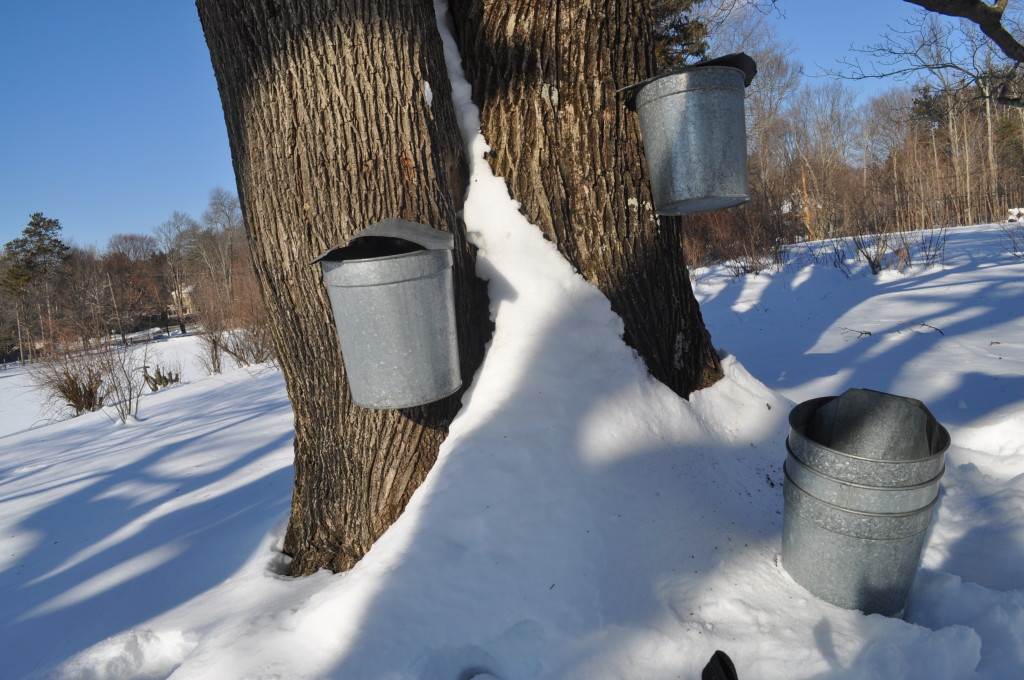 We use a “tree-saver” spile that has a smaller diameter than traditional spiles, making it healthier for the tree in the long run. This less intrusive, more compact model doesn’t open the tree up to possible infection in the same way as traditional spiles. This year, 100% of our trees will be tapped with the tree-saver spile!
We use a “tree-saver” spile that has a smaller diameter than traditional spiles, making it healthier for the tree in the long run. This less intrusive, more compact model doesn’t open the tree up to possible infection in the same way as traditional spiles. This year, 100% of our trees will be tapped with the tree-saver spile!

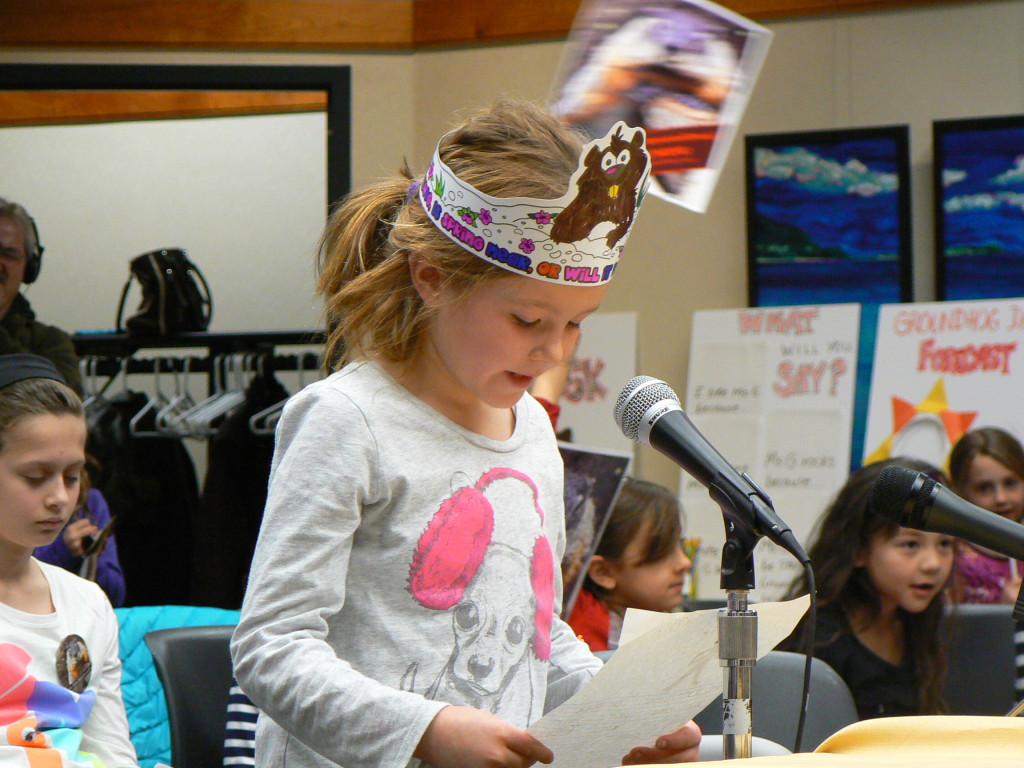

 After an opening charge from Governor Deval Patrick, which unveiled Massachusetts STEM Plan 2.0, we spent the day buzzing about the complex, turning the box seats around the Patriots playing field into working laboratories for learning the latest philosophies, techniques, and tools for engaging students in STEM learning.
After an opening charge from Governor Deval Patrick, which unveiled Massachusetts STEM Plan 2.0, we spent the day buzzing about the complex, turning the box seats around the Patriots playing field into working laboratories for learning the latest philosophies, techniques, and tools for engaging students in STEM learning. During breaks, we wandered the exhibit halls, finding inspiration from the many nonprofit organizations, there to share their mission and opportunities, including Mass Audubon. Even the lunch-time presentation provided new ideas and inspiration, as we heard two young engineers share their passion and entrepreneurship in their journey to create a line of personally-piloted flying cars through their company Terrafugia.
During breaks, we wandered the exhibit halls, finding inspiration from the many nonprofit organizations, there to share their mission and opportunities, including Mass Audubon. Even the lunch-time presentation provided new ideas and inspiration, as we heard two young engineers share their passion and entrepreneurship in their journey to create a line of personally-piloted flying cars through their company Terrafugia. So if Mass Audubon is all about protecting the nature of Massachusetts, why did we devote a whole day inside to the STEM Summit? At the heart of how we approach our mission is finding ways to bring people closer to their environment through a process of science-based discovery. Over time, we have found innovative ways to incorporate math, engineering, and technology into our nature-based programming as well. Finding new ways to excite and engage our students in science will lead them to a deeper appreciation of the natural world, and subsequently a desire to protect it for future generations. At the same time, discovering ways to access nature through exciting new technologies and teaching tools helps us plug into kids and learning opportunities that we, and they, might not have found through more traditional methods. As we ourselves grow as educators through dynamic experiences such as an immersive day at the STEM Summit, we are able to bring new energy and ideas to our students back at Drumlin Farm, creating our own STEM revolution here in the fields, forests, and wetlands.
So if Mass Audubon is all about protecting the nature of Massachusetts, why did we devote a whole day inside to the STEM Summit? At the heart of how we approach our mission is finding ways to bring people closer to their environment through a process of science-based discovery. Over time, we have found innovative ways to incorporate math, engineering, and technology into our nature-based programming as well. Finding new ways to excite and engage our students in science will lead them to a deeper appreciation of the natural world, and subsequently a desire to protect it for future generations. At the same time, discovering ways to access nature through exciting new technologies and teaching tools helps us plug into kids and learning opportunities that we, and they, might not have found through more traditional methods. As we ourselves grow as educators through dynamic experiences such as an immersive day at the STEM Summit, we are able to bring new energy and ideas to our students back at Drumlin Farm, creating our own STEM revolution here in the fields, forests, and wetlands.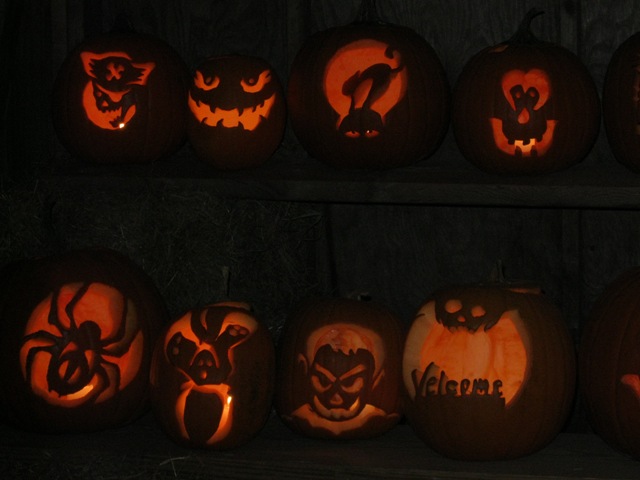 On Wednesday, corporate volunteers from CA Technologies, Dassault Systems, Meketa Investment Group and Intel Corporation donated their creativity and elbow grease. Volunteers carved pumpkins to contribute to our display of 150 jack-o-lanterns. They created a spooky graveyard, stretched spider webs across fences, dug fire pits to light the way for the Haunted Hayride, and assembled some of the friendliest scarecrows around. Decorating the farm is a large endeavor, and we were so grateful to have had our corporate volunteers to help. Several families contributed pumpkins to our jack’o-lantern display as well.
On Wednesday, corporate volunteers from CA Technologies, Dassault Systems, Meketa Investment Group and Intel Corporation donated their creativity and elbow grease. Volunteers carved pumpkins to contribute to our display of 150 jack-o-lanterns. They created a spooky graveyard, stretched spider webs across fences, dug fire pits to light the way for the Haunted Hayride, and assembled some of the friendliest scarecrows around. Decorating the farm is a large endeavor, and we were so grateful to have had our corporate volunteers to help. Several families contributed pumpkins to our jack’o-lantern display as well. It takes a platoon of volunteers to run Tales of the Night smoothly and ensure that our visitors have a spook-tacular evening. Luckily for the Drumlin Farm staff, we had many individuals willing to act as zombies, witches and ghouls on the Haunted Hayride. Others entertained young children and the fainter of heart on the Nursery Rhyme Trail, where Mother Goose tells stories and Little Miss Muffet fends off the giant spider. At the face painting station, volunteers drew designs on countless children’s cheeks. And we couldn’t forget the good-natured volunteers who served refreshments, assisted at the admission window and directed parking.
It takes a platoon of volunteers to run Tales of the Night smoothly and ensure that our visitors have a spook-tacular evening. Luckily for the Drumlin Farm staff, we had many individuals willing to act as zombies, witches and ghouls on the Haunted Hayride. Others entertained young children and the fainter of heart on the Nursery Rhyme Trail, where Mother Goose tells stories and Little Miss Muffet fends off the giant spider. At the face painting station, volunteers drew designs on countless children’s cheeks. And we couldn’t forget the good-natured volunteers who served refreshments, assisted at the admission window and directed parking. Please accept a heart-felt thank you to all
Please accept a heart-felt thank you to all 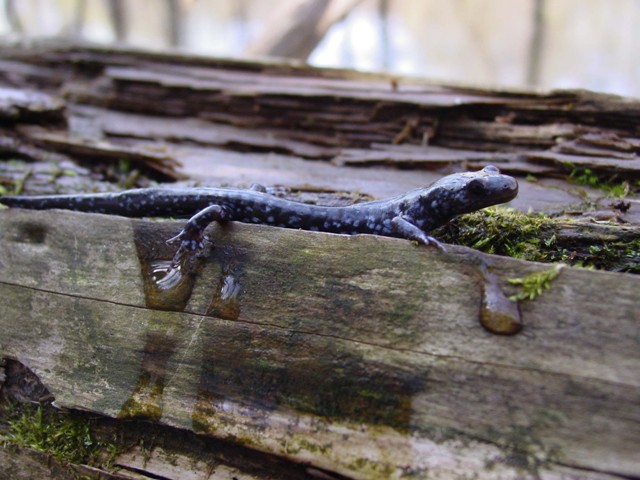 Drumlin Farm is home to many species of amphibians and reptiles. Ice Pond is a great place to spot many spring peepers, American toads, and painted turtles. Garter snakes are common, and the occasional milk snake will appear, too. Rotting logs along the trails provide habitat for amphibians, including this blue spotted salamander.
Drumlin Farm is home to many species of amphibians and reptiles. Ice Pond is a great place to spot many spring peepers, American toads, and painted turtles. Garter snakes are common, and the occasional milk snake will appear, too. Rotting logs along the trails provide habitat for amphibians, including this blue spotted salamander. American Toad: American toads have a brown shade of skin with dark spots on their backs. Each spot contains only one or two warts, a distinguishing feature from other toads, and may be circled with a white or yellow ring. Like other toads, American toads have poisonous glands behind the head that are toxic when ingested, provided defense against predators.
American Toad: American toads have a brown shade of skin with dark spots on their backs. Each spot contains only one or two warts, a distinguishing feature from other toads, and may be circled with a white or yellow ring. Like other toads, American toads have poisonous glands behind the head that are toxic when ingested, provided defense against predators.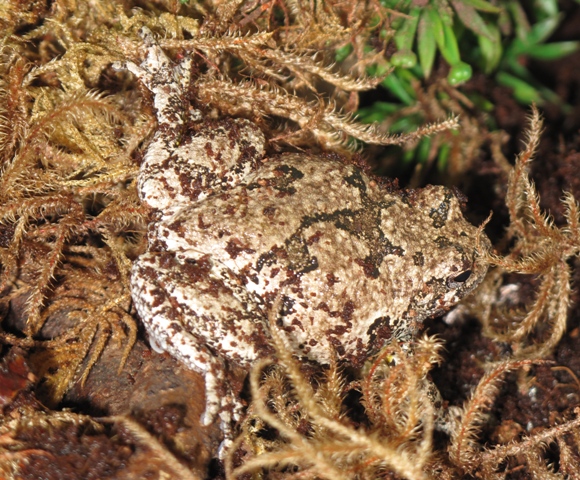 Gray Treefrog: Gray treefrogs are the only treefrog found in Massachusetts. Inhabiting in wooded areas near water sources, the frogs are often found on damp logs. Glycerol in the blood makes the gray treefrog the only Massachusets frog that can freeze — up to 80% of the body can freeze during winter hibernation. Gray treefrogs are often used by scientists as an indicator of chemical contaminants and the overall level of biodiversity in the environment.
Gray Treefrog: Gray treefrogs are the only treefrog found in Massachusetts. Inhabiting in wooded areas near water sources, the frogs are often found on damp logs. Glycerol in the blood makes the gray treefrog the only Massachusets frog that can freeze — up to 80% of the body can freeze during winter hibernation. Gray treefrogs are often used by scientists as an indicator of chemical contaminants and the overall level of biodiversity in the environment.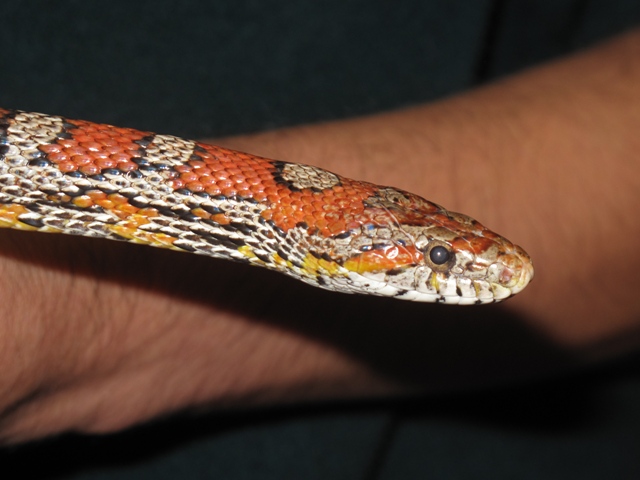 Corn snakes: Unlike the rest of the collection at Drumlin Farm, corn snakes are not native to Massachusetts. Our two corn snakes were former pets, and therefore cannot survive in the wild. Corn snakes are not venomous, and they are known to have a docile nature, which makes them a good choice for educational programs.
Corn snakes: Unlike the rest of the collection at Drumlin Farm, corn snakes are not native to Massachusetts. Our two corn snakes were former pets, and therefore cannot survive in the wild. Corn snakes are not venomous, and they are known to have a docile nature, which makes them a good choice for educational programs. Snapping Turtle: Snapping turtles have extremely long necks, which allow them to reach around half of the shells. Most turtles have robust shells to hide from predators, but the bottom piece (called a plastron) of a snapping turtle shell is small, and exposes much of the turtles flesh. This allows snapping turtles to be stronger, but makes them more accessible to predators. The wide range of motion in the neck and the powerful jaw helps the snapping turtle make-up for its smaller shell.
Snapping Turtle: Snapping turtles have extremely long necks, which allow them to reach around half of the shells. Most turtles have robust shells to hide from predators, but the bottom piece (called a plastron) of a snapping turtle shell is small, and exposes much of the turtles flesh. This allows snapping turtles to be stronger, but makes them more accessible to predators. The wide range of motion in the neck and the powerful jaw helps the snapping turtle make-up for its smaller shell.